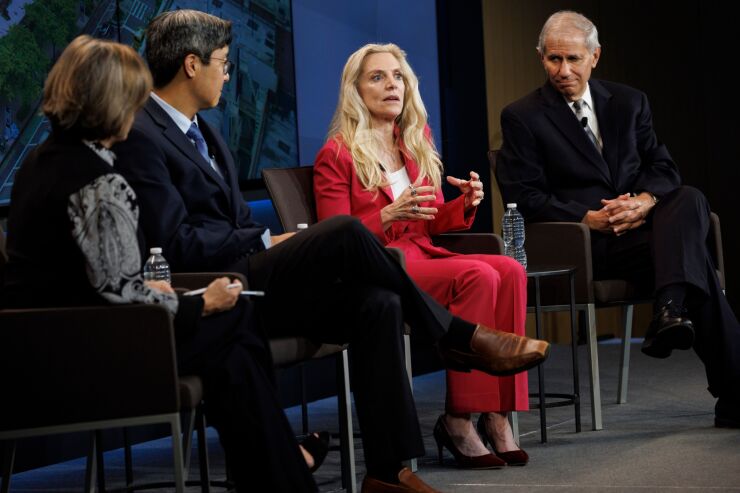Bank regulators approved a merger between U.S. Bank and Union-MUFG Friday while simultaneously introducing new standards for large banks' resolution plans.
In a joint statement released Friday, the agencies announced they would seek public comment on a host of potential changes to
Potential changes include a requirement that large bank organizations, also known as large regional banks or domestic systemically important banks, hold certain types of long-term debt to absorb losses. The agencies are also considering whether these banks should face modified versions of several standards already applied to larger, global systemically important banks, or G-SIBs.

Fed Vice Chair Lael Brainard said the growth in size and complexity of the banks in the target range — those with between roughly $250 billion and $700 billion — in recent years raises concerns. Because of this, she said, a review of resolution standards is warranted.
"Since we know from experience that even non-complex banks in that range can pose risks to the broader financial system when they experience financial distress, I am encouraged that the Board is seeking comment on an advance proposal to improve their resolvability through long-term debt requirements and is undertaking a serious review of large bank capital requirements," Brainard said in a statement.
The Fed is seeking public feedback on proposed changes such as a requirement that large banks be subjected to some level of "clean" holding company requirements, resolution guidance and disclosure requirements, all of which imposed on GSIBs. It also considers separability requirements, that would have large banks sell off parts of its business to avoid needing to be acquired outright by another firm.
The proposal does not call for large banks to hold total loss-absorbing capital, a requirement for GSIBs that some policy specialists have floated as a potential option for large-bank resolution.
The joint announcement from the Fed and FDIC comes roughly
The proposed rule came just as the Federal Reserve Board and Office of the Comptroller of the Currency announced the approval of U.S. Bancorp's application to acquire MUFG-Union Bank, which included the stipulation that U.S. Bank provide the Fed and FDIC with an updated resolution plan and its implementation plan to meet heightened regulatory standards.
In a statement released Friday afternoon, U.S. Bank noted that the transaction was still waiting on approval from Japanese regulators but it expected the acquisition to close by the end of the year.
"We are pleased to have received U.S. regulatory approval," U.S. Bank Chairman, President and CEO Andy Cecere said in the statement. "We believe that this acquisition is good for customers, good for the communities that MUFG Union Bank has served and good for employees. It allows us to make investments to serve customers and enhance competition on the West Coast. We share many common values with MUFG Union Bank and we look forward to having their employees and customers join the U.S. Bancorp family."

Both the proposed changes to resolution planning and the Fed's approval of U.S. Bank's acquisition drew criticism from Republican-appointed governors on the board.
Fed Gov. Michelle Bowman said she supported the decision to accept U.S. Bank's acquisition application, but noted that the resolution conditions attached could violate Fed's existing regulatory framework.
From a regulatory perspective, U.S. Bank is deemed a Category III bank, those with between $250 billion and $700 billion. It will remain a Category III bank even after the Union Bank acquisition. However, Bowman noted, the Fed's order indicates that U.S. Bank might have to reclassify as a Category II bank in 2024 when it submits its next resolution plan, a higher designation that comes with more stringent requirements.
Bowman said changing a bank's status based on a predetermined time frame rather than its size or systemic risk would violate the Fed's tailoring rule, which dictates specific requirements based on the amount of assets they hold and their exposures to certain risk categories.
"This determination does not appear to be driven by any specific concern about financial stability," Bowman said in a statement. "If the Board believes that the firm should be subject to heightened prudential standards in the future to address financial stability concerns, the Board's rules and regulations provide a means to do so."
Category II status typically applies to banks with at least $700 billion of assets. U.S. Bank currently has $601 billion.
Bowman also raised some concerns about the proposed changes to resolution planning, highlighting the importance of avoiding unintended consequences. Specifically, she pointed to the proposal for large banks to hold long-term debts could cause liquidity constraints and prevent the free flow of credit.
Fed Gov. Chris Waller also issued a statement noting that he would pay careful attention to the public responses received before giving his support to a resolution reform package.
"While I support issuing an advance notice of proposed rulemaking to solicit public comment on the appropriateness of certain resolution-related requirements for large banks, that does not mean I support or oppose applying such requirements to those banks," Waller said. "I look forward to reviewing the comments received."
The proposed rulemaking will be available for public comment on the Federal Register for 60 days.





